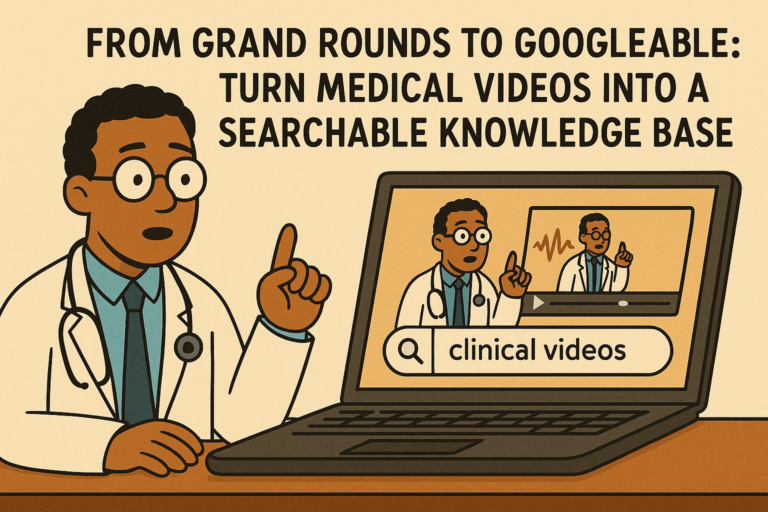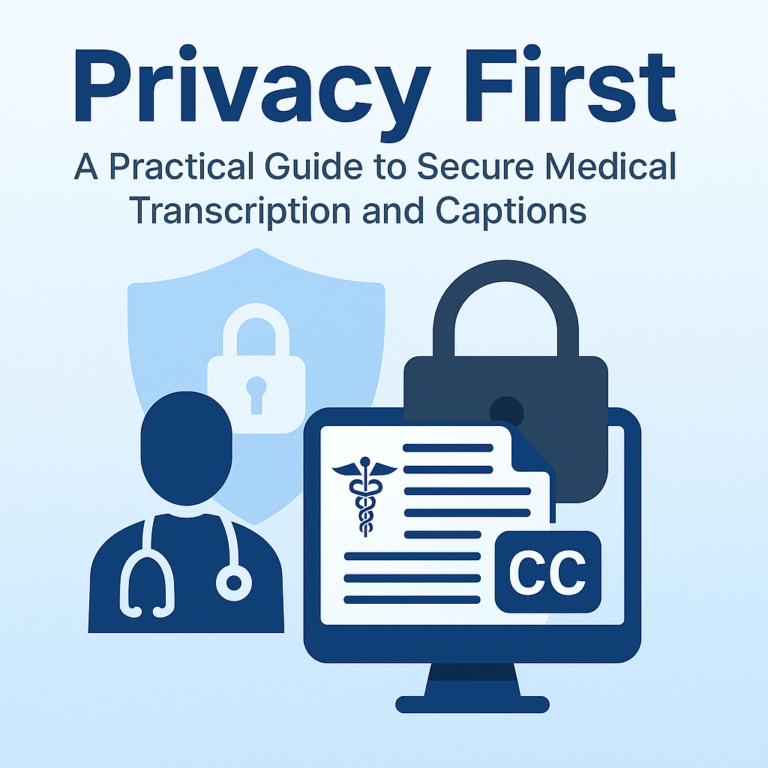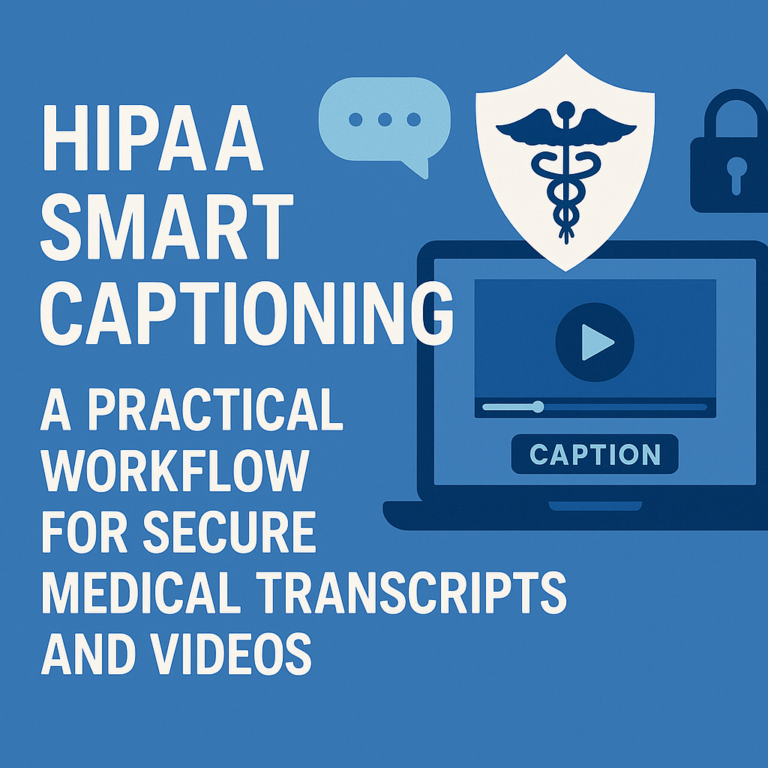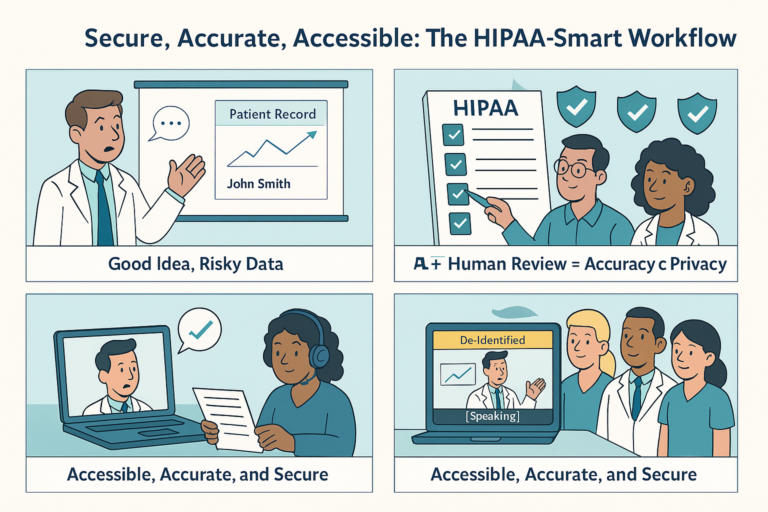A cardiology fellow pauses the video. “Did she say 0.5 mg/kg or 5 mg/kg?” In medicine, a single missing zero can turn a good lecture into a confusing one. Captions are more than words on a screen—they’re safety rails for comprehension, especially when the content is fast, technical, and high stakes. That’s why medical videos need a style guide built for medicine, not just media.
Note: This guide focuses on clarity and accessibility in educational and professional content. It is not clinical or legal advice.
Why Medicine Needs Its Own Caption Style
Medical content carries unique risks and expectations:
Dense terminology: anatomy, pharmacology, devices, and eponyms fly by fast.
Numbers matter: doses, vitals, ranges, and units can’t be ambiguous.
Multi-speaker settings: panels, OR teams, and bedside demos need clear speaker labels.
Accessibility and inclusion: captions help deaf and hard-of-hearing viewers, non-native speakers, and tired clinicians at 11 p.m. after call.
MedXcribe is fine tuned on medical data to produce highly accurate transcriptions, but the last mile—how those words appear—can make or break understanding. Use the rules below as your team’s shared playbook.
The 12 Rules of Medical Caption Clarity
1) Prioritize meaning over filler
Remove “um,” “uh,” and false starts unless they add context. Keep hesitations if they change meaning (e.g., uncertainty in a diagnosis).
2) Expand unsafe abbreviations
Avoid error-prone shorthand: use daily (not qd), units (not U), micrograms (not µg), milliliters (not cc), and left/right (not L/R) when ambiguity is possible. When in doubt, spell it out.
3) Numbers and units are nonnegotiable
– Use numerals for doses, vitals, labs, and statistics: 5 mg, 98%, 7.4 pH.
– Include a leading zero before decimals: 0.5 mg, not .5 mg.
– Put a space between number and unit (5 mg) except for percentages (98%).
– For ranges, use “to” for clarity: 15 to 20 mg, not 15–20 mg.
4) Drug names and doses
– Use generic names in lowercase unless a brand is explicitly discussed (insulin glargine; Lantus when comparing brands).
– Capture dose, route, and frequency when spoken: cefazolin 2 g IV every 8 hours.
– If the salt form is clinically relevant and mentioned, include it (metoprolol tartrate vs succinate).
5) Acronyms and first mention
On first use, expand and then abbreviate: acute respiratory distress syndrome (ARDS). Thereafter, use ARDS consistently.
6) Greek letters, symbols, and ions
Spell out Greek letters: alpha, beta, gamma. For ions, write potassium (K+) or calcium (Ca2+) as spoken; don’t assume the symbol if it wasn’t said.
7) Time, speed, and counts
– Use 24-hour time if the speaker does (14:00). If ambiguous, prefer descriptive text: at 2 p.m.
– For heart rate, respiratory rate, and other per-minute values, include the unit as spoken: 90 beats per minute, 20 breaths per minute.
8) Speaker labels for teams
When there are multiple voices, label clearly on first appearance and as needed: Dr. Lopez:, Nurse:, Patient:, Moderator:. Keep labels short and consistent.
9) Capture on-screen text that matters
If the video relies on slides, device readings, or labels, include them succinctly: [Slide: Management Algorithm], [Monitor: SpO2 92%], [Ultrasound: gallbladder wall thickening].
10) Note relevant non-speech audio
Add brief brackets for meaningful sounds: [alarm beeping], [scissors cutting suture], [applause], [laughter]. Skip background noise that doesn’t inform.
11) Readability beats density
– Aim for no more than 2 lines per caption.
– Keep each line concise (roughly 42 characters) and readable at a glance.
– Target a comfortable reading speed (around 15–20 characters per second). Break lines at natural phrase boundaries.
12) Protect privacy in educational content
De-identify when needed: [name redacted], [DOB redacted]. Avoid disclosing patient identifiers unless you have explicit consent for educational use.
A Simple, Reliable Workflow with AI + Human Review
1) Prepare your term list
Before transcription, jot down key terms: drug names, device models, anatomy, trial acronyms, and speaker names. This “cheat sheet” increases precision during review.
2) Generate a draft with MedXcribe
Upload your audio or video. Because MedXcribe is trained on medical data, you’ll start with a strong baseline: terminology, drug names, and procedures are typically recognized correctly even in fast lectures.
3) Apply the style pass
– Numbers and units: sweep for leading zeros, spacing, and ranges.
– Abbreviations: expand unsafe ones; standardize acronyms.
– Speaker labels: add or refine in panel discussions.
– On-screen text: insert [bracketed] cues only where they clarify the content.
4) Validate against source material
Cross-check with slides, captions on medical devices, and any posted references. When in doubt, replay difficult sections at reduced speed or check a second source.
5) Final polish and export
Keep formatting consistent across the whole video series. Export to standard caption formats (e.g., SRT or VTT) and preview on the target platform to verify timing, contrast, and line breaks.
Pro Tips for Common Medical Scenarios
Procedures and OR videos: Prioritize steps, instruments, and safety calls. Label speakers when multiple voices overlap.
Journal clubs: Include key data points from figures and tables if the speaker relies on them for the argument.
Patient education: Use plain language when the presenter does; define jargon the first time it appears.
Multilingual names and terms: Preserve original pronunciation where possible; avoid anglicizing drug names if the correct term is clear.
The Takeaway
Great captions don’t just repeat audio—they resolve ambiguity. In medicine, that means getting doses, units, names, and steps unmistakably right. Pair MedXcribe’s medically tuned transcription with a simple, shared style guide, and you’ll bring lectures, procedures, and patient education to life for every learner.
Ready to try? Run your next lecture or procedure video through MedXcribe, apply the 12 rules, and share the style guide with your team. Clear captions start here.






